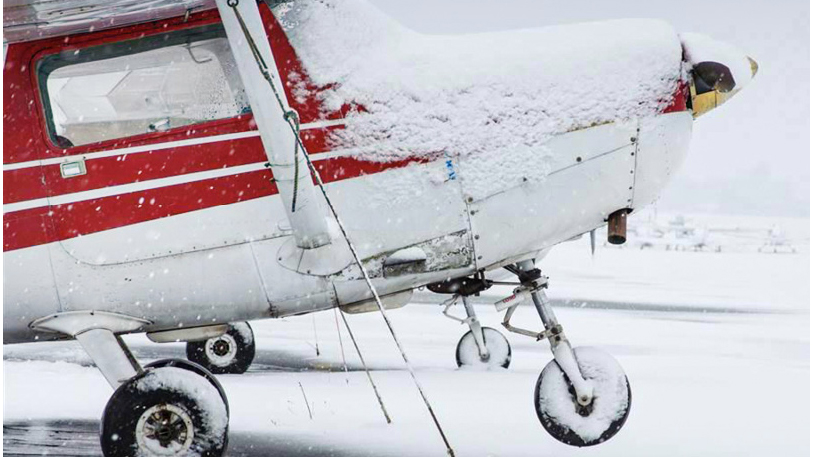Telling our story
Communications team connects AOPA with the world

Our community is as remarkably diverse as our individual stories. However, there is one common idea that is shared by all AOPA pilots—a love of flight.
The AOPA Communications team, operating out of its offices in Frederick, Maryland, promotes and helps grow the incredible privilege that we call general aviation. Whether it is through educating the public about the fun and the utility that aircraft can provide, preparing resources and training material to enhance information in the news and media, or advocating for aviation through our communications efforts—it is our job to maintain the interest in, and strength and vitality of, the flying community.
AOPA Communications connects reporters with in-house experts on a variety of aviation topics. We follow through on national stories that impact general aviation and we find, meet, and report on the unique individuals who make up the general aviation community. We tell the stories of GA to all who will listen—and we make sure general aviation’s story is told accurately, responsibly, and true to our mission.
AOPA’s mission is to ensure that the sky remains within reach of everyone who dreams of becoming a pilot. The communications team shortens that reach by exposing the joy of flight to the world.
Email [email protected]
MEDIA ROOM
Press Releases. News from the association.
News. What’s happening in the world of general aviation.
Downloads. Logos, photos, brand awareness.
Calendar of Events. Fly-ins, events, and things to do.
AOPA Leadership. Meet the association’s leaders.
AOPA in the news. Who’s talking about us.
Statistics, economic impact. GA’s impact on the national and local economies.
Media contact: Jennifer Non
Senior manager, media relations and public affairs
301-695-2214 | [email protected]

AOPA Air Safety Institute
Ice on the deck
Why you need to take this weather phenomenon seriously
By Alicia Herron
Any amount of ice on a light GA airplane is a big deal, and as we inch toward winter, now is a good time to examine the hazards of icing and some tips to deal with them.
Ice or frost accumulations increase drag and rob an aircraft of critical lift. When you add power to compensate for the additional drag and lift the aircraft’s nose to maintain altitude, the angle of attack increases, allowing the underside of the wings and fuselage to accumulate additional ice. Accumulations no thicker or rougher than coarse sandpaper on the leading edge and upper surface of a wing can reduce lift by as much as 30 percent and increase drag by as much as 40 percent. Because of this, the airplane may stall at lower angles of attack and at a much higher 1-G airspeed than normal.
Loss of lift isn’t the only problem. Ice accumulates on every exposed frontal surface of the airplane—not just on the wings, propeller, and windshield, but also on the antennas, vents, intakes, and cowlings. Ice builds in flight where no heat or deicing boots can reach it, and it can cause antennas to vibrate so severely that they break. In moderate to severe conditions, a light aircraft can become so iced up that continued flight is impossible.
The threat of icing isn’t limited to regions typically associated with colder weather. Even in historically snow-free areas, the freezing level can drop dramatically in winter. If you don’t already, add checking the freezing level to your preflight planning to help avoid icing conditions.
Here are some tips to help deal with icing:
- Any amount of structural icing is hazardous.
- Conduct thorough preflight planning and include backup plans.
- Ensure the aircraft is completely free of frost, snow, and ice before departure.
- Get out of icing conditions immediately, as soon as you suspect or see ice forming on the aircraft.
- Depending on the cloud type, icing can be worse in the top of the clouds, so only climb if you’re certain you can climb over the top.
- Give and use pireps to help improve weather decision making.
Take ice seriously. Even a small amount can dramatically change the way your airplane flies, and if not dealt with immediately, can become a major and potentially unrecoverable problem.
Learn more about icing with this safety spotlight: airsafetyinstitute.org/spotlight/precipandicing
Email [email protected]
Turn on your notifications
On your feed
Fly with AOPA
Leaf peeping
 Looking forward to crisp fall flights? Tell us where you go to fly over the foliage.
Looking forward to crisp fall flights? Tell us where you go to fly over the foliage.
#flywithaopa, @bropilots_aviation
AOPA’s PILOT PASSPORT:
Home for the Holidays challenge
Over the river and through the woods…. Are you heading to your hometown for Thanksgiving? Participate in the “Home for the Holidays” AOPA Pilot Passport November challenge by checking in to one of the program’s geographical regions and earn badges. Maybe you’ll fly over several regions? There are six regions in the Pilot Passport Program: Central Southwest, Eastern, Great Lakes, Northwest Mountain, Southern, and Western Pacific. If you’re planning a trip home, consider making it more fun—and increasing your chances to win AOPA pilot gear—by participating in this month’s challenge. The top three win select gear from the AOPA Pilot Store.
The AOPA Pilot Passport Program on the AOPA app encourages pilots to check in at different types of airports; land at airports across your state; visit airports across the country; and share your experiences by rating the airport, uploading photos, and posting comments on social media (use #AOPAPilotPassport in your posts).
aopa.org/travel/pilot-passport
Looking for more?
Instagram: @flywithaopa, Twitter: @aopa, Facebook: AOPA: your freedom to fly, AOPA Live
Post of the month
 Surfing the clouds
Surfing the clouds
Cloud surf sesh.
#flywithaopa @flywithberger
Tag @flywithaopa for your chance to be featured on this page.

Member Products and Services
Medically Speaking
Communicating with the FAA: Tips for getting your medical through the system
About 95 percent of the 275,000 average annual applications for a medical certificate result in an issuance of the medical certificate by the aviation medical examiner. Those that require further review are deferral to the FAA for a decision. If you’re one of that 5 percent who for whatever reason weren’t issued your medical in the office, the FAA Aerospace Medical Certification Division (AMCD) will send you a letter stating, “We are unable to establish your eligibility to hold a medical certificate at this time.”
In most cases, the application is deferred because of something that’s reported in the medical history and/or medication usage items of the MedXPress application. Most likely, the FAA letter will ask for information specific to what was reported on the application. The letter you get will have a reference number called a “PI number.” That number is unique to you, so use it in all your correspondence.
- Give the FAA only what it asks for—nothing more, nothing less. An application for a medical certificate is considered by the FAA to be the first step in an “investigation” to determine if you are in fact eligible for the medical certificate for which you applied. Don’t volunteer any information that wasn’t requested.
- Put your PI number on all document pages.
- Read through all the records you get from your health care provider. Since we all make mistakes, there may be errors that don’t pertain to your medical history. Better to catch that sooner rather than have the FAA come back asking more questions.
- Make copies. With the volume of records the FAA gets, things do sometimes get lost and you don’t want to have to go back to health care providers and re-create everything.
- Be patient. Things don’t happen quickly once the records are entered in the system.
- Submit all the requested information in one mailing. If you send in records piecemeal, that will bring the review process to a standstill.
The FAA knows it has process problems, and a new management system is in the works for 2021 that should help some—but the bureaucracy will still be there and automation, technology, and work efficiency still can’t overpower the government’s need to keep the airspace safe by critical review of the medical certification process.
Gary Crump is the senior director of medical certification for the AOPA Pilot Information Center.

 MEET ERIC BLINDERMAN, AOPA SENIOR DIRECTOR OF COMMUNICATIONS
MEET ERIC BLINDERMAN, AOPA SENIOR DIRECTOR OF COMMUNICATIONS
